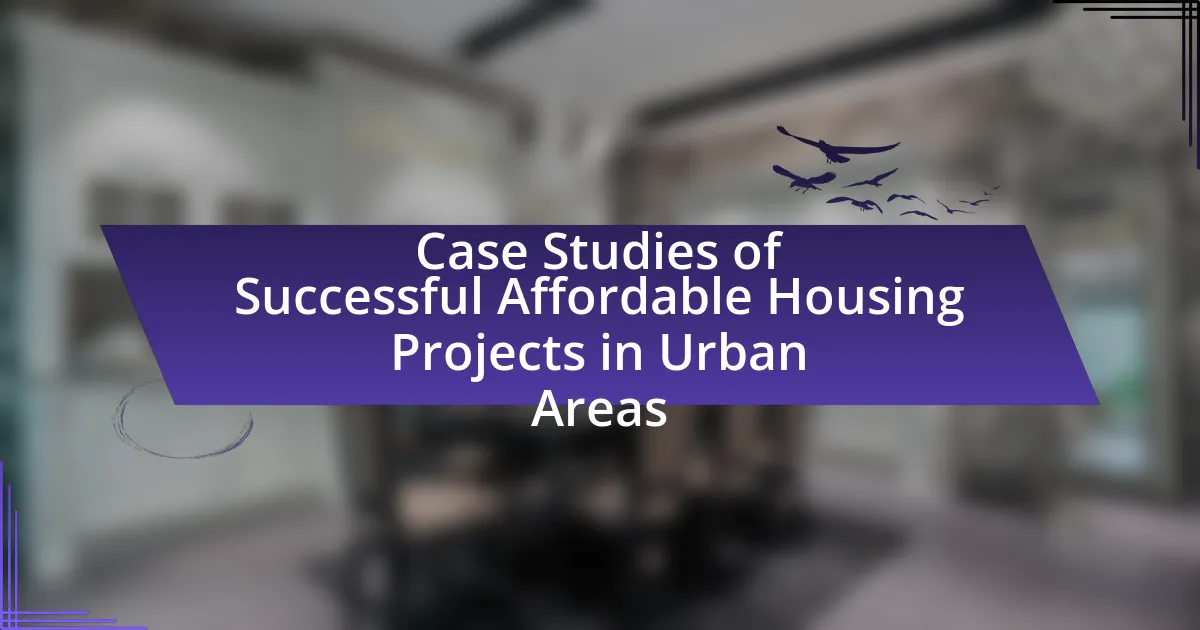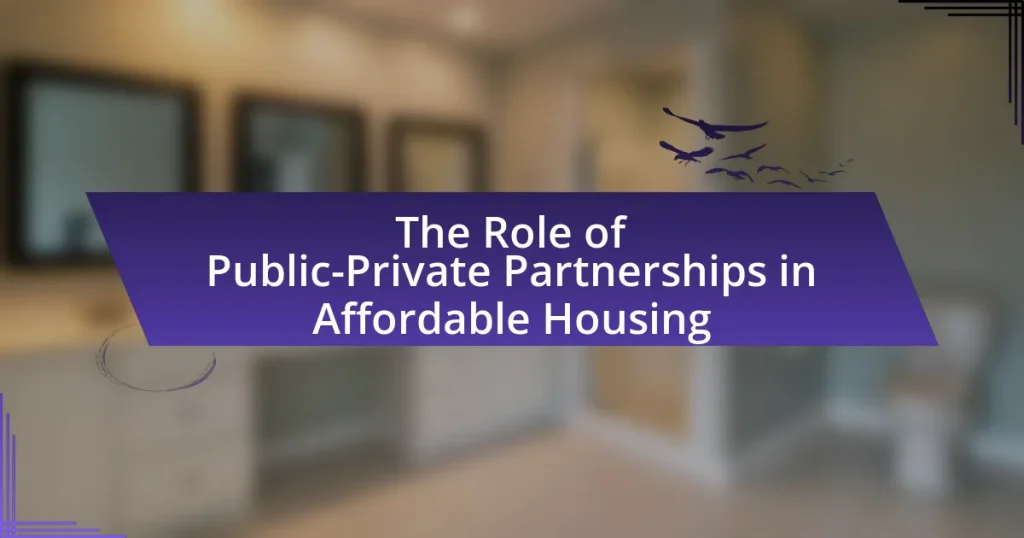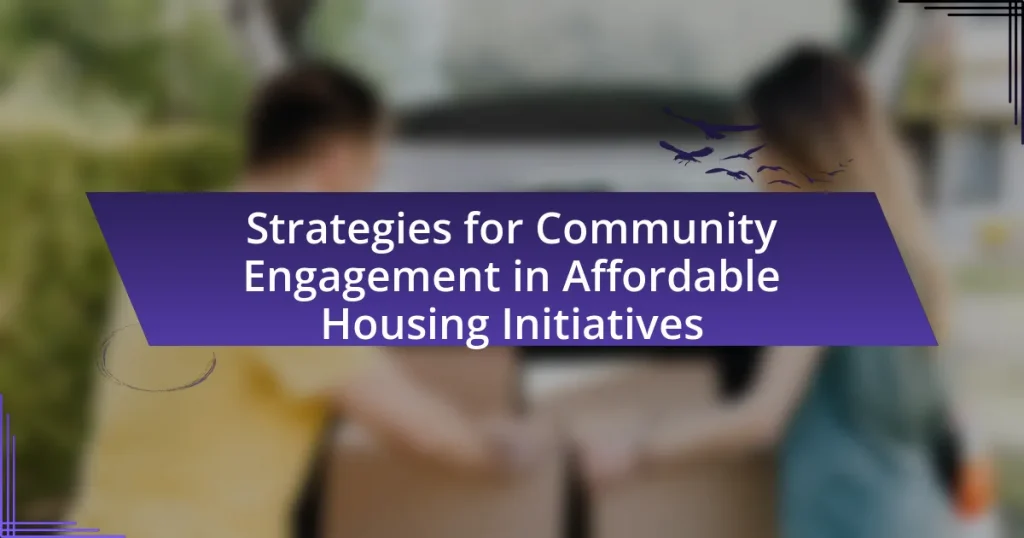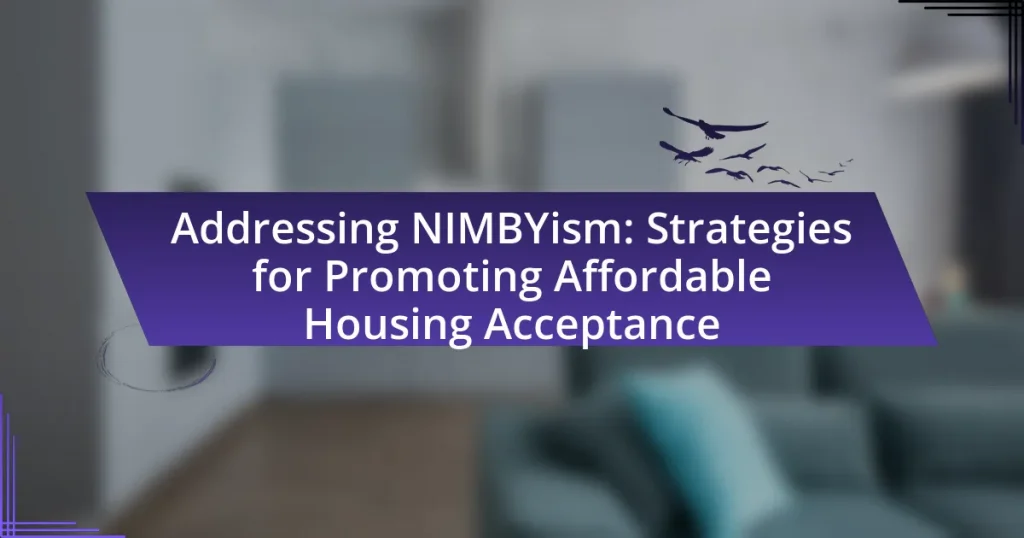The article focuses on case studies of successful affordable housing projects in urban areas, highlighting notable examples such as the Via Verde project in the Bronx and the 3D-printed homes initiative in Austin. It defines success in affordable housing through metrics like occupancy rates, cost per unit, and resident satisfaction, while emphasizing the importance of community needs and engagement in shaping project outcomes. The article also discusses the challenges urban areas face regarding housing affordability and outlines effective strategies and policies that have been implemented to address these issues, ultimately showcasing best practices for future affordable housing developments.
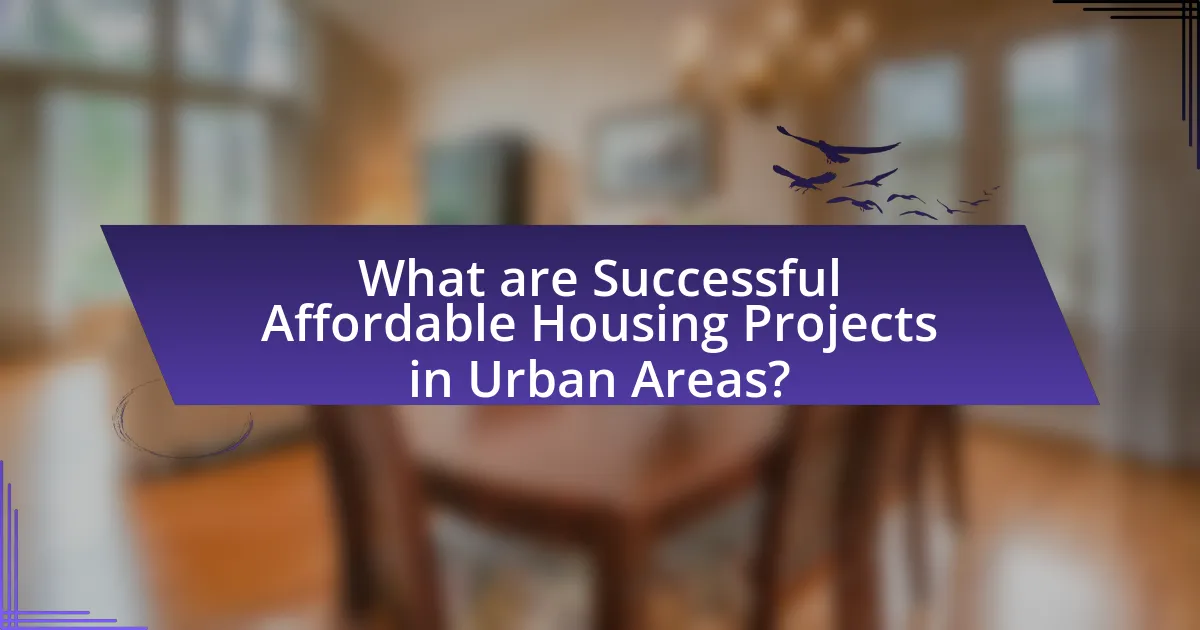
What are Successful Affordable Housing Projects in Urban Areas?
Successful affordable housing projects in urban areas include the Via Verde project in the Bronx, New York, and the 3D-printed homes initiative in Austin, Texas. Via Verde, developed by Jonathan Rose Companies and Phipps Houses, features 222 affordable units and integrates green design principles, resulting in lower utility costs and improved living conditions. The project received the 2012 American Institute of Architects Honor Award for its innovative approach to sustainable living. In Austin, the 3D-printed homes initiative aims to reduce construction costs significantly, with homes being built for approximately $10,000 each, showcasing a potential solution to the housing crisis. These projects exemplify successful strategies in addressing urban housing affordability while promoting sustainability and community well-being.
How do we define success in affordable housing projects?
Success in affordable housing projects is defined by the ability to provide safe, quality, and accessible housing for low- to moderate-income individuals and families. This definition encompasses several key metrics, including the number of units built, the affordability of housing relative to income levels, and the overall satisfaction of residents. For instance, a successful project often achieves a rent-to-income ratio of 30% or less, which is widely recognized as a benchmark for affordability. Additionally, projects that foster community engagement and improve residents’ quality of life, such as access to public services and transportation, further exemplify success in this sector.
What metrics are used to measure success in these projects?
Success in affordable housing projects is typically measured using metrics such as occupancy rates, cost per unit, and resident satisfaction. Occupancy rates indicate the percentage of available units that are occupied, reflecting demand and project viability. Cost per unit assesses the financial efficiency of the project, allowing stakeholders to evaluate budget adherence and resource allocation. Resident satisfaction is often gauged through surveys, providing insights into the quality of living conditions and community engagement. These metrics collectively offer a comprehensive view of a project’s success in meeting its objectives and serving the community effectively.
How do community needs influence the definition of success?
Community needs significantly influence the definition of success by shaping the criteria used to evaluate outcomes in affordable housing projects. When a community prioritizes access to safe, affordable housing, success is defined not just by the number of units built, but also by the quality of life improvements for residents, such as increased access to services, reduced homelessness, and enhanced community cohesion. For instance, a study by the Urban Institute highlights that successful affordable housing initiatives are those that meet specific local needs, such as proximity to public transportation and employment opportunities, thereby demonstrating that community input directly impacts success metrics.
Why are affordable housing projects crucial in urban areas?
Affordable housing projects are crucial in urban areas because they provide essential living options for low- and moderate-income families, helping to alleviate homelessness and housing instability. Urban areas often experience high demand for housing, leading to increased rents and displacement of vulnerable populations. According to the National Low Income Housing Coalition, there is a shortage of 7 million affordable rental homes for extremely low-income renters in the United States, highlighting the urgent need for such projects. By increasing the availability of affordable housing, these projects contribute to economic diversity, community stability, and improved quality of life for residents.
What challenges do urban areas face regarding housing affordability?
Urban areas face significant challenges regarding housing affordability, primarily due to high demand and limited supply. Rapid population growth in cities increases competition for housing, driving up prices. Additionally, zoning regulations and land use policies often restrict the development of new housing units, exacerbating the supply shortage. Economic factors, such as rising construction costs and stagnant wages, further hinder affordability. According to a report by the National Low Income Housing Coalition, in 2021, a worker earning minimum wage could afford only 7% of rental homes in the U.S., highlighting the disparity between income levels and housing costs.
How do affordable housing projects address these challenges?
Affordable housing projects address challenges such as high housing costs, inadequate supply, and homelessness by providing low-cost living options that meet the needs of low- and moderate-income families. These projects often utilize government subsidies, tax incentives, and public-private partnerships to lower construction costs and ensure affordability. For instance, the Low-Income Housing Tax Credit program has facilitated the development of over 3 million affordable housing units in the United States since its inception in 1986, demonstrating a successful model for addressing housing shortages. Additionally, affordable housing projects often incorporate community services and amenities, which enhance residents’ quality of life and promote social stability.

What are some notable case studies of successful affordable housing projects?
Notable case studies of successful affordable housing projects include the 161st Street Development in the Bronx, New York, which provides 100% affordable units and integrates community services. Another example is the Via Verde project in the Bronx, which combines affordable housing with sustainable design, featuring green roofs and energy-efficient systems. The East Lake Community in Chicago transformed a public housing site into a mixed-income community, significantly reducing crime and improving residents’ quality of life. These projects demonstrate effective strategies for creating affordable housing while enhancing community well-being and sustainability.
How did the East Lake Community in Atlanta achieve success?
The East Lake Community in Atlanta achieved success through a comprehensive revitalization strategy that included mixed-income housing, community engagement, and educational initiatives. This approach transformed a previously distressed area into a thriving neighborhood by integrating affordable housing with market-rate options, thereby fostering economic diversity. The East Lake Foundation played a crucial role by investing in social services, including early childhood education and job training programs, which significantly improved residents’ quality of life. As a result, crime rates decreased by over 50%, and property values increased, demonstrating the effectiveness of this holistic model in urban redevelopment.
What strategies were implemented in the East Lake Community project?
The East Lake Community project implemented several key strategies, including comprehensive community engagement, mixed-income housing development, and the establishment of supportive services. Community engagement involved collaboration with residents to identify needs and priorities, ensuring that the project aligned with their aspirations. The mixed-income housing strategy aimed to create a diverse community by integrating affordable housing with market-rate units, which helped to reduce stigma and promote social cohesion. Additionally, the project provided supportive services such as job training, education programs, and health services, which contributed to the overall well-being and empowerment of residents. These strategies collectively transformed the East Lake area into a thriving community, demonstrating the effectiveness of holistic approaches in urban affordable housing initiatives.
What were the outcomes of the East Lake Community initiative?
The outcomes of the East Lake Community initiative included significant improvements in housing quality, economic stability, and community engagement. The initiative transformed a previously distressed neighborhood in Atlanta, Georgia, into a thriving community by providing affordable housing, educational opportunities, and access to essential services. As a result, the crime rate decreased by 50%, and property values increased substantially, with homeownership rates rising from 5% to over 50%. Additionally, the initiative fostered a sense of community, leading to increased resident participation in local governance and activities.
What lessons can be learned from the Via Verde project in the Bronx?
The Via Verde project in the Bronx teaches several key lessons about successful affordable housing development. Firstly, it emphasizes the importance of integrating sustainable design with community needs, as the project incorporates green roofs and energy-efficient systems, which contribute to lower utility costs for residents. Secondly, the project highlights the value of mixed-income housing, fostering social diversity and economic stability within the community. Additionally, community engagement during the planning process proved crucial, as it ensured that the design met the specific needs and desires of local residents. These lessons underscore the significance of sustainability, inclusivity, and collaboration in creating effective affordable housing solutions.
How did design and sustainability play a role in Via Verde’s success?
Design and sustainability were crucial to Via Verde’s success by creating a vibrant, eco-friendly community that meets the needs of its residents. The project incorporated green roofs, energy-efficient systems, and sustainable materials, which not only reduced environmental impact but also lowered utility costs for residents. For instance, the green roofs contribute to stormwater management and enhance biodiversity, while energy-efficient appliances and systems lead to significant energy savings. These design elements fostered a sense of community and improved the quality of life, making Via Verde a model for affordable housing that prioritizes both livability and environmental responsibility.
What community engagement strategies were used in the Via Verde project?
The Via Verde project employed several community engagement strategies, including participatory design workshops, regular community meetings, and collaboration with local organizations. These strategies facilitated direct input from residents, ensuring that their needs and preferences were incorporated into the project. For instance, the participatory design workshops allowed community members to express their ideas and concerns, which were then integrated into the architectural plans. Additionally, the project team maintained ongoing communication with the community through regular meetings, fostering transparency and trust. Collaborating with local organizations helped to mobilize resources and support, further enhancing community involvement and ownership of the project.

What are the key factors contributing to the success of affordable housing projects?
The key factors contributing to the success of affordable housing projects include effective community engagement, sustainable financing models, and strong partnerships among stakeholders. Effective community engagement ensures that the needs and preferences of residents are prioritized, leading to higher satisfaction and lower turnover rates. Sustainable financing models, such as public-private partnerships and innovative funding mechanisms, provide the necessary capital while minimizing reliance on government subsidies. Strong partnerships among stakeholders, including local governments, non-profits, and private developers, facilitate resource sharing and enhance project viability. These factors have been evidenced in successful projects like the Atlanta BeltLine, which integrated community input and diverse funding sources to create affordable housing options while revitalizing urban spaces.
How does community involvement impact project outcomes?
Community involvement significantly enhances project outcomes by fostering collaboration, ensuring that the needs and preferences of local residents are addressed. Engaging the community in the planning and execution phases of affordable housing projects leads to increased support, reduced opposition, and a greater sense of ownership among residents. For instance, a study by the Urban Institute found that projects with active community participation saw a 30% increase in resident satisfaction and a 25% reduction in project delays. This evidence underscores the critical role that community involvement plays in achieving successful and sustainable project results.
What methods can be used to engage the community effectively?
To engage the community effectively, participatory planning methods should be utilized, which involve community members in the decision-making process. These methods include community workshops, surveys, and focus groups that gather input and feedback from residents, ensuring their voices are heard in the development of affordable housing projects. Research shows that projects incorporating community engagement, such as the “Community Engagement in Housing Development” study by the Urban Institute, lead to higher satisfaction and better outcomes for residents, demonstrating the importance of involving the community in the planning stages.
How does community feedback shape project development?
Community feedback significantly shapes project development by ensuring that the needs and preferences of local residents are integrated into the planning and execution phases. This engagement leads to more relevant and sustainable outcomes, as evidenced by the success of affordable housing projects that actively involve community input. For instance, the “Community Engagement in Affordable Housing” study by the Urban Institute highlights that projects incorporating resident feedback experience higher satisfaction rates and lower rates of opposition, ultimately resulting in smoother implementation and greater community support.
What role does government policy play in supporting affordable housing?
Government policy plays a crucial role in supporting affordable housing by establishing regulations, funding mechanisms, and incentives that promote the development and preservation of affordable units. Policies such as zoning laws can facilitate higher-density housing, while funding programs like the Low-Income Housing Tax Credit provide financial support to developers. For instance, the National Low Income Housing Coalition reports that the tax credit has financed over 3 million affordable homes since its inception in 1986, demonstrating the effectiveness of government intervention in addressing housing shortages. Additionally, policies that encourage public-private partnerships can leverage resources and expertise, further enhancing the availability of affordable housing options in urban areas.
What policies have proven effective in promoting affordable housing projects?
Policies that have proven effective in promoting affordable housing projects include inclusionary zoning, tax incentives, and public-private partnerships. Inclusionary zoning mandates that a percentage of new developments be set aside for affordable housing, which has been successfully implemented in cities like San Francisco, resulting in thousands of affordable units. Tax incentives, such as the Low-Income Housing Tax Credit in the United States, have stimulated the construction of affordable housing by providing financial benefits to developers, leading to the creation of over 3 million affordable housing units since its inception in 1986. Public-private partnerships leverage resources and expertise from both sectors, exemplified by initiatives in New York City that have resulted in the development of mixed-income housing projects, effectively increasing the availability of affordable units.
How can local governments facilitate successful project implementation?
Local governments can facilitate successful project implementation by establishing clear policies and frameworks that support affordable housing initiatives. These frameworks can include streamlined permitting processes, financial incentives such as tax credits or grants, and the creation of public-private partnerships that leverage resources and expertise. For instance, the City of San Diego implemented a program that reduced the time for project approvals, which led to a significant increase in the number of affordable housing units developed. Additionally, local governments can engage community stakeholders in the planning process to ensure that projects meet the needs of residents, thereby increasing public support and reducing opposition. This approach has been shown to enhance project viability and sustainability, as evidenced by the successful implementation of the Affordable Housing Trust Fund in Boston, which involved extensive community input and collaboration.
What best practices can be adopted for future affordable housing projects?
Future affordable housing projects should adopt best practices such as community engagement, sustainable design, and mixed-income development. Community engagement ensures that the needs and preferences of residents are considered, leading to higher satisfaction and lower turnover rates. Sustainable design incorporates energy-efficient materials and technologies, which can reduce long-term operational costs; for instance, projects that utilize solar panels can decrease energy expenses by up to 50%. Mixed-income development fosters economic diversity and stability within neighborhoods, as evidenced by the success of the Hope VI program, which revitalized public housing by integrating market-rate units, resulting in improved community outcomes and increased property values.
How can project developers ensure long-term sustainability?
Project developers can ensure long-term sustainability by integrating environmentally friendly practices, community engagement, and financial viability into their projects. Implementing energy-efficient designs and utilizing sustainable materials reduces environmental impact and operational costs. Engaging with the community fosters a sense of ownership and ensures that the housing meets local needs, which can lead to higher occupancy rates and lower turnover. Financially, securing diverse funding sources and creating adaptable designs that can evolve with changing demographics contribute to the project’s longevity. Studies show that projects incorporating these elements, such as the Green Building Council’s LEED certification, demonstrate improved sustainability outcomes and community satisfaction.
What innovative financing options are available for affordable housing projects?
Innovative financing options for affordable housing projects include social impact bonds, community land trusts, and low-income housing tax credits. Social impact bonds allow private investors to fund housing initiatives, with returns tied to the success of the project in achieving social outcomes, such as reduced homelessness. Community land trusts enable communities to acquire and manage land, ensuring long-term affordability by separating land ownership from housing development. Low-income housing tax credits provide tax incentives to developers, encouraging the construction and rehabilitation of affordable housing units. These financing mechanisms have been successfully implemented in various urban areas, demonstrating their effectiveness in addressing housing affordability challenges.
